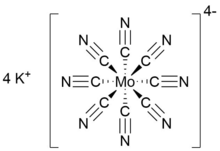Potassium octacyanomolybdate(IV)
Potassium octacyanomolybdate(IV) is the inorganic salt with the formula K4[Mo(CN)8]. A yellow light-sensitive solid, it is the potassium salt of the cyanometalate with the coordination number eight. The complex anion consists of a Mo(IV) center bound to eight cyanide ligands resulting in an overall charge of −4, which is balanced with four potassium cations. The salt is often prepared as its dihydrate K4[Mo(CN)8].(H2O)2.

| |

| |
| Names | |
|---|---|
| IUPAC name
Potassium octacyanidomolybdate(IV)
| |
| Other names
Potassium octacyanomolybdate(IV)
| |
| Identifiers | |
| |
3D model (JSmol)
|
|
PubChem CID
|
|
| |
| |
| Properties | |
| K4[Mo(CN)8] | |
| Molar mass | 460,47 g/mol (anhydrous) 496.5 g/mol (dihydrate) |
| Appearance | yellow powder |
| Melting point | >300 °C |
| Hazards | |
| GHS labelling: | |

| |
| Warning | |
| H302, H315, H319, H335 | |
| P261, P305+P351+P338 | |
Except where otherwise noted, data are given for materials in their standard state (at 25 °C [77 °F], 100 kPa).
| |
Preparation
editThe dihydrate K4[Mo(CN)8] · 2 H2O can be prepared by the reduction of molybdate (MoO42-) with potassium borohydride (KBH4) in a solution with potassium cyanide and acetic acid.[1][2] Yields of 70% are typical and the method is suited for scale-up.
- 4 MoO42- + 32 CN− + BH4− + 25 H+ → 4 [Mo(CN)8]4- + 13 H2O + H3BO3
An alternative route starts from MoCl4(Et2O)2 avoiding the need for reductants. The yield of this route is typically around 70%.[3] This synthesis is convenient for lower batch sizes than the earlier method but the MoCl4(Et2O)2 is typically less available than the molybdate.
- MoCl4(Et2O)2 + 8 KCN → K4[Mo(CN)8] + 4 KCl + 2 Et2O
Reactions
editOctacyanomolybdate(IV) can be oxidized to the paramagnetic octacyanomolybdate(V).
The cyanide ligands in [Mo(CN)8]4- remain basic. Strong acids lead to the hydrogen isocyanide complex [Mo(CNH)8]4+, in common with many cyanometalate complexes.[4] These ligands can be substituted by others, for example H2O. The cyanide ligands also bind to other metals, leading to cages.[2]
References
edit- ^ Leipoldt, J. G.; Bok, L. D. C.; Cilliers, P. J. (1974). "The Preparation of Potassium Octacyanomolybdate(IV) Dihydrate". Zeitschrift für anorganische und allgemeine Chemie. 409 (3): 343–344. doi:10.1002/zaac.19744090310.
- ^ a b Bonadio, Federica; Larionova, Joulia; Gross, Mathias; Biner, Margret; Stoeckli-Evans, Helen; Decurtins, Silvio; Pilkington, Melanie (2004). "Cyanide Compounds". Inorganic Syntheses. Vol. 34. p. 156. doi:10.1002/0471653683.ch4. ISBN 978-0-471-64750-8.
- ^ G. Handzlik, M. Magott, B. Sielucka, D. Pinkowicz, "Alternative Synthetic Route to Potassium Octacyanidoniobate(IV) and its Molybdenum Congener", Eur. J. Inorg. Chem., 2016, pp. 4872-77.doi:10.1002/ejic.201600669
- ^ M. Sellin, V. Marvaud, M. Malischewski, "Isolation and Structural Characterization of Eightfold Protonated Octacyanometalates [M(CNH)8]4+ (M=MoIV, WIV) from Superacids", Angew. Chem. Int. Ed., 2020 volume 59, pp. 10519-10522.doi:10.1002/anie.202002366